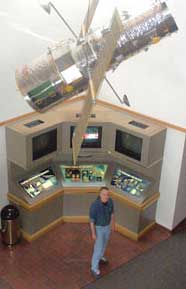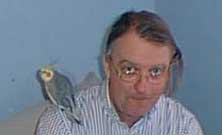Biography
I’ve been writing my bio for my upcoming high school reunion. It’s turning into a multi page thing because there is So Much stuff that’s happened to me over the course of my life, but so far I haven’t been asked to trim it. As of this morning I was still tweaking it, still adding things here and there, because it all comes together to put me at the Space Telescope Science Institute where I retired last February. There are some who might wonder how the hell someone like me, with no college degree and let’s face it, a confused unkempt little high school dork got a job like that and was suddenly executing tests for a billion dollar space telescope over the deep space network. What the hell anyway??
And it occurs to me that my life was a lot like one of those episodes of James Burke’s TV series Connections. If you haven’t watched it I highly recommend it. In it he makes the point repeatedly, it’s the basis for the entire series, that change happens, not exactly randomly, but from people working on things in their own area of interest, borrowing or inspired by people before them who did things in their areas of interest, and nobody really knows while they’re working in their areas of interest, what might come out of it…
An invention acts rather like a trigger, because, once it’s there, it changes the way things are, and that change stimulates the production of another invention, which in turn, causes change, and so on. Why those inventions happened, between 6,000 years ago and now, where they happened and when they happened, is a fascinating blend of accident, genius, craftsmanship, geography, religion, war, money, ambition… Above all, at some point, everybody is involved in the business of change, not just the so-called “great men.” Given what they knew at the time, and a moderate amount of what’s up here [pointing to head], I hope to show you that you or I could have done just what they did, or come close to it, because at no time did an invention come out of thin air into somebody’s head, [snaps fingers] like that. You just had to put a number of bits and pieces, that were already there, together in the right way. -James Burke, Connections – The Trigger Effect
So I’m looking back at my life and how I got here, to being retired, comfortably if not fabulously, in a little Baltimore rowhouse after having worked on two of the great NASA space telescopes, and I still have no college degree, and in many ways I am still that unkempt little dork I was way back when.
First, I wanted to be a cartoonist and a painter. My high school art teacher introduced me to photography as an art form. I did cartoons and photography for my student newspaper, which led me to also wanting to be a news photographer. I became none of that, but it led me to a job as an architectural model maker. I could simulate various building materials with paint and a little ingenuity. Because…
As a kid I became fascinated by building model cars, submarines, airplanes. But eventually the kits bored me and I began improvising. So that fed into making architectural models. I began learning how to read and then scale architectural drawings. You don’t build those things on the fly, so I began learning how to think a process through from an initial set of requirements to the finished thing, before I started work. I began to essentialize shapes and forms in my mind. A complex model could be reduced to basic forms that you could build on.
My maternal grandfather was a radio pioneer back in the days of the first radio stations. He made, then sold and serviced other company’s radios. He died in his middle 40s, in the middle 1940s. All though my childhood anything that mom saw in me that reminded her of her dad she encouraged, even though we didn’t have a lot of money I got Heathkits, Radio Shack kits, and such. When I developed an interest in shortwave radio, because it was kinda fun to listen to the world and before the Internet shortwave was how you did that, I also began dumpster diving for old radios, and getting them working again. Which led me to…
I bought my first computer, a Commodore C64, so I could read radio teletype broadcasts. There was a program cartridge you plugged in, and tuning box you could attach to the speaker of your radio, and see the words appear on the screen. The Commodore’s user interface was a Basic interpreter, written for Commodore by Microsoft. I began fiddling with writing simple Basic programs, just for kicks. In programming, it helps to be able to visualize the program flow in your head because you can’t actually see it. You can reduce the basic operations of a program to simple forms you can build on. There’s the architectural model making…weirdly enough.
At a HAM radio fest where I was searching for tubes to fix a radio I was working on, I discovered I could build an IBM PC compatible from parts being sold there, because the HAMs were using them for their own radio teletype broadcasts. I could have never afforded an actual IBM PC, or any of the compatibles being sold then. But I could buy a part here and there until I had enough to build one. And when I did, I continued teaching myself to write programs, but now with a much more powerful computer, that had access to much more powerful software development tools.
After one particularly successful project for the architectural model maker I was working for, he gave me a bonus, and with it I bought a copy of Microsoft PDS (Professional Development System) Basic. It came with Microsoft’s first cut of the Jet database machine, which would later become Microsoft Access. So again…there’s the architectural model making. I began learning relational database design and wrote my own contact manager.
With the PC I also began surfing not the internet, which wasn’t yet open to the public, but the world of amature computer bulletin boards. It started I was looking for “shareware” software to run, and message forums to talk with other computer hobbyists. I began learning about networking, and network protocols.
I’m a gay man, and I was also looking for online community, not being comfortable with or good looking enough for the bars. There’s the dork again. I connected with some gay BBS message boards and there I saw what the technology could do for us. At the time everything I knew about homosexuals and homosexuality I got from the culture around me, which was either venomously hostile, or rancidly pitious. Now I saw we no longer had to see ourselves with heterosexual eyes. No matter where we were, in the gay friendly city neighborhoods or hostile rural zones, we could talk freely to each other. It was a revelation that committed me to computer networking…
…which led me to G.L.I.B., the Gay and Lesbian Information Bureau: a gay BBS whose owner wanted it to be an information and knowledge resource for the gay community. There I met, naturally, a bunch of other computer nerds. I volunteered to help out with operations, and began to write software for them.
One of our members worked for a wire service and he got us a daily news digest of all the gay related news articles off the wires. I was stunned at how much of it there was, that you never saw anywhere. We were still people best not spoken of in family newspapers. I wrote a program to take the daily wire service news digest, break it into individual articles and upload them to the BBS along with updated menus for the users. I began learning how to design and write software systems, individual pieces of software that came together to fulfill a task, and which could be reused for other tasks.
Late in the 1980s, the Silverado Savings and Loan scandal bankrupted the people I was building architectural models for, and I was left desperate for work. A classmate let me live in his basement and there were months I could not pay him rent. He let it slide and I am forever grateful. I posted a message for help on GLIB and one of the men who ran it gave me work writing business software for his company. There’s where it all comes together. My lucky big break, though I didn’t know it at the time.
I wrote several business systems for him, including a membership tracking system for a local gay activist group. They had licensed copies of Word Perfect and dBase4, and I wrote a menu driven membership database system that let them print welcome letters with envelopes every month to new members, reminders of coming dues, and enter and edit the data of existing members.
That eventually led me to getting work as a contract software developer. I did contract work for a number of companies, including Baltimore Gas and Electric, Sorbus, Litton-Amecom, and Becton-Dickinson. Eventually I got a contract at the Space Telescope Science Institute. A year later they made me an offer to come on board as staff and I thought I’d died and gone to heaven. I continued writing business software, because science needs business software too, to track money and progress, for the Hubble Space Telescope Grant Management System, and eventually for the James Webb Space Telescope.
I was still building my own computers from parts because then I ended up with exactly what I wanted in a computer. My team needed computers to test our applications on but we didn’t have a lot of money in our budget for it, and so, because I’d told them I built my own computers, I was asked to build my team a set of test computers for the software we were deploying to the community. I built them four from all the spare parts and castoffs I could scrounge up. I used swappable hard drive trays to allow me to load whatever operating system I needed to run tests on. I set the test lab up with a custom set of iptables firewalls and every morning ran a program that went through the system logs looking for anyone trying to break into any of it and it sent me a morning digest. From inside our firewalls anyone on the team could run tests once I set a machine up with the right operating system.
That got me notice from management and they put me to work on the team that was building the JWST Mission Operations Center. There I set up and administered a small testing lab for JWST science operations software systems (store bought computers this time…we had money now…), wrote more business programs that tracked progress, captured and catalogued telemetry from the spacecraft cryo chamber tests, and eventually ended up in the flight operations room, conducting the early initial end to end tests in the Flight Operations room, across the NASA deep space network.
After that was turned over to Goddard flight engineers, I did performance testing in the backrooms of the MOC, almost all the way to Launch.
So. From cartoons and painting, to architectural models, from radios to computers, online gay activism to contract software engineering, to Hubble and then to James Webb.
And there’s a bunch more off on a different path…cartoons and painting to architectural model making to computers to online activism to cartoons and photography for local gay papers to work on a film documentary and getting screen credit and an entry in the Internet Movie Database.
As I wrote in my high school reunion bio, it’s not a life I ever expected to have when I graduated in 1972. I had a lot of low expectations dumped on me when I was a kid, growing up with a divorced single mom, which wasn’t helped by being part of a despised minority. But mom loved me and set a good example, and I did some really good stuff along the way. I marched with other gay folk out of the shadows and into the mainstream. I kept on doing my photography, my artwork, had a couple shows, got my cartoons into newspapers. I worked on two of NASAs major space telescopes. We harvested light from near the dawn of time and gave it to science to study. We added a few lines to the book of knowledge.
What a trip it was. Connections.
The question is in what way are the triggers around us likely to operate to cause things to change — for better or worse. And, is there anything we can learn from the way that happened before, so we can teach ourselves to look for and recognize the signs of change? The trouble is, that’s not easy when you have been taught as I was, for example, that things in the past happened in straight-forward lines. I mean, take one oversimple example of what I’m talking about: the idea of putting the past into packaged units — subjects, like agriculture. The minute you look at this apparently clear-cut view of things, you see the holes. I mean, look at the tractor. Oh sure, it worked in the fields, but is it a part of the history of agriculture or a dozen other things? The steam engine, the electric spark, petroleum development, rubber technology. It’s a countrified car. And, the fertilizer that follows; it doesn’t follow! That came from as much as anything else from a fellow trying to make artificial diamonds. And here’s another old favorite: Eureka! Great Inventors You know, the lonely genius in the garage with a lightbulb that goes ping in his head. Well, if you’ve seen anything of this series, you’ll know what a wrong approach to things that is. None of these guys did anything by themselves; they borrowed from other people’s work. And how can you say when a golden age of anything started and stopped? The age of steam certainly wasn’t started by James Watt; nor did the fellow whose engine he was trying to repair — Newcomen, nor did his predecessor Savorey, nor did his predecessor Papert. And Papert was only doing what he was doing because they had trouble draining the mines. You see what I’m trying to say? This makes you think in straight lines. And if today doesn’t happen in straight lines — think of your own experience — why should the past have?
-James Burke, Connections – Yesterday, Tomorrow and You







































